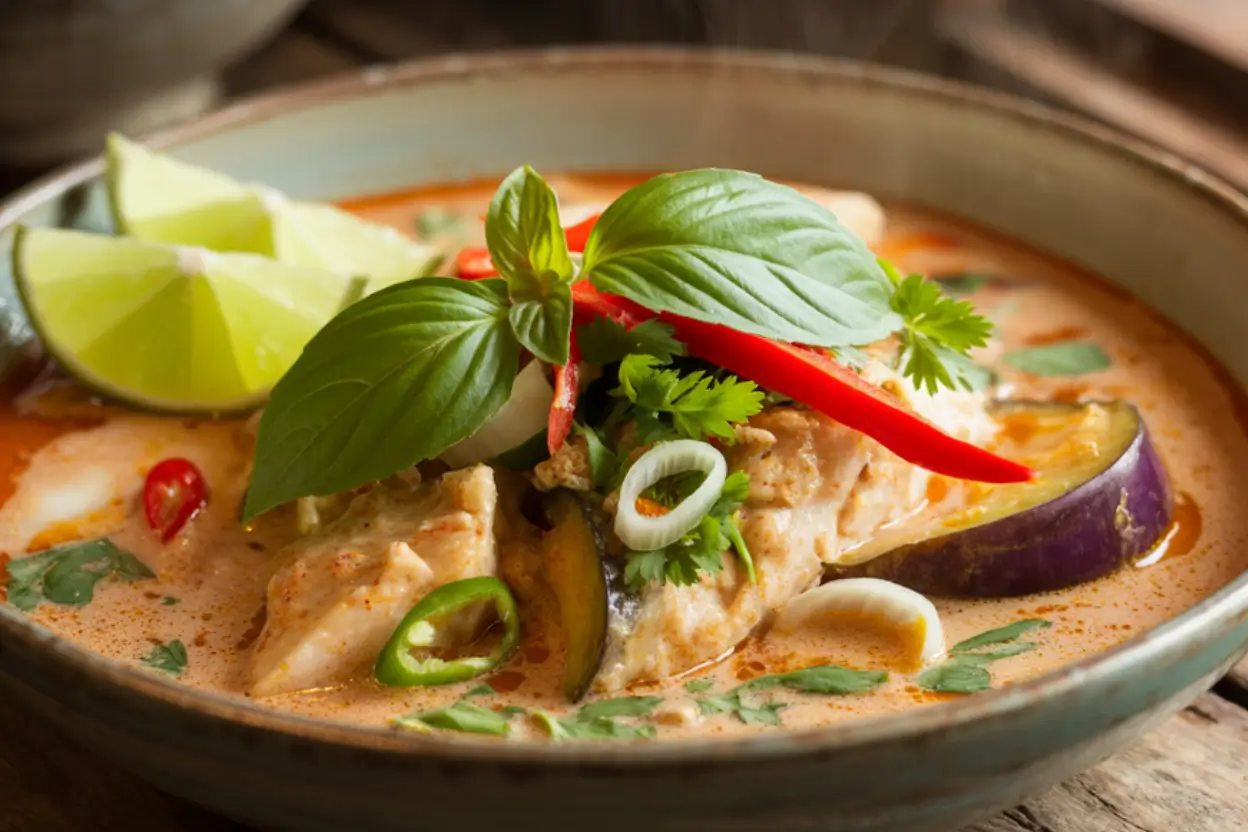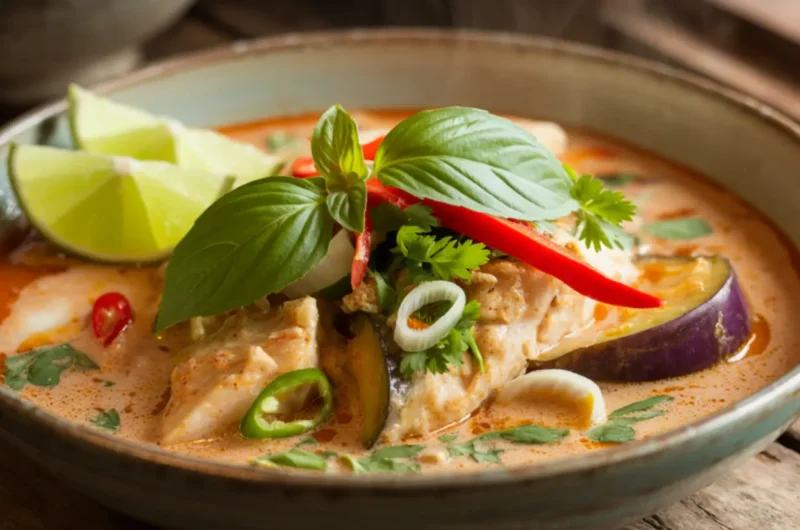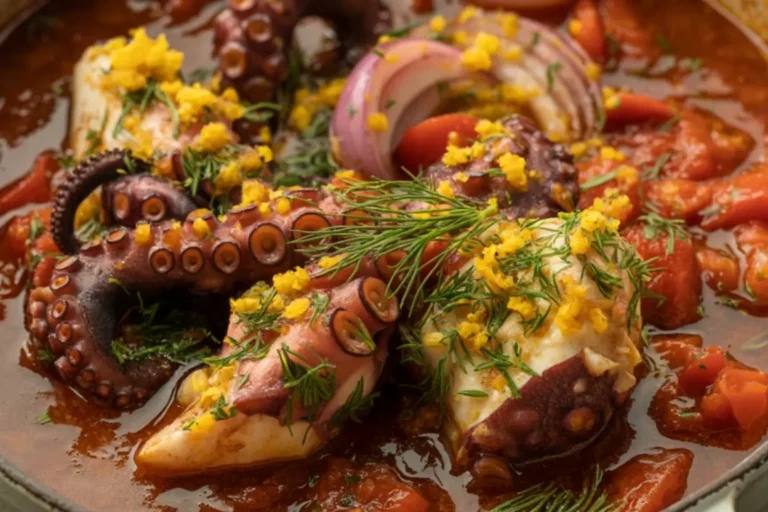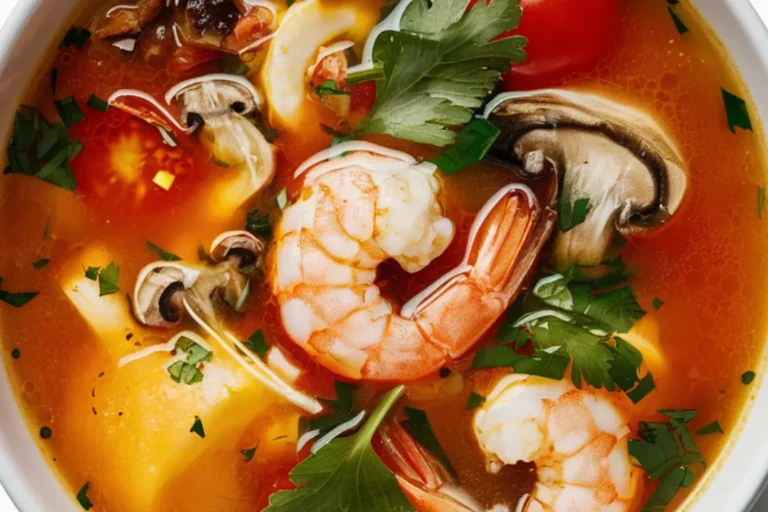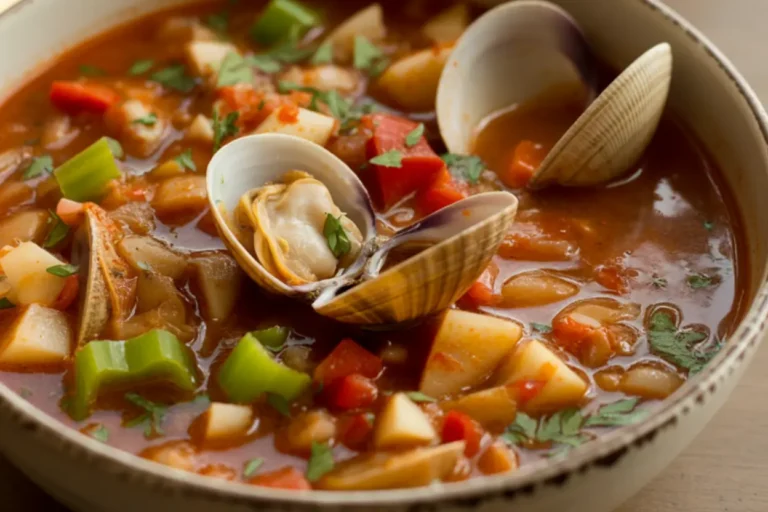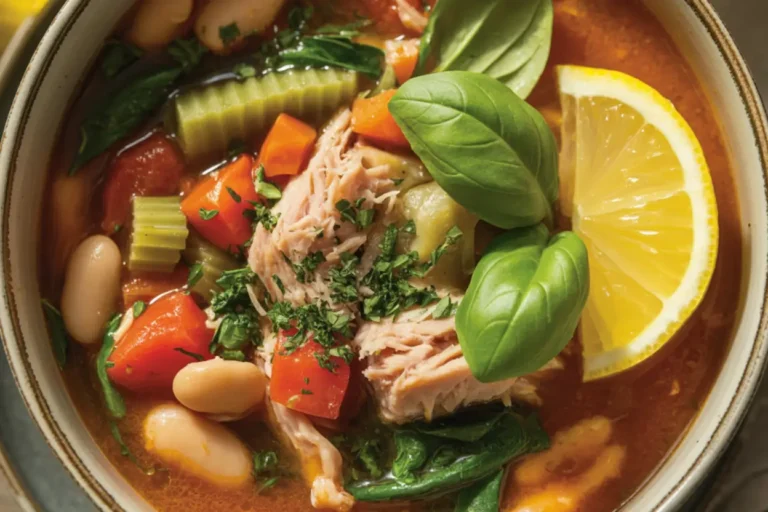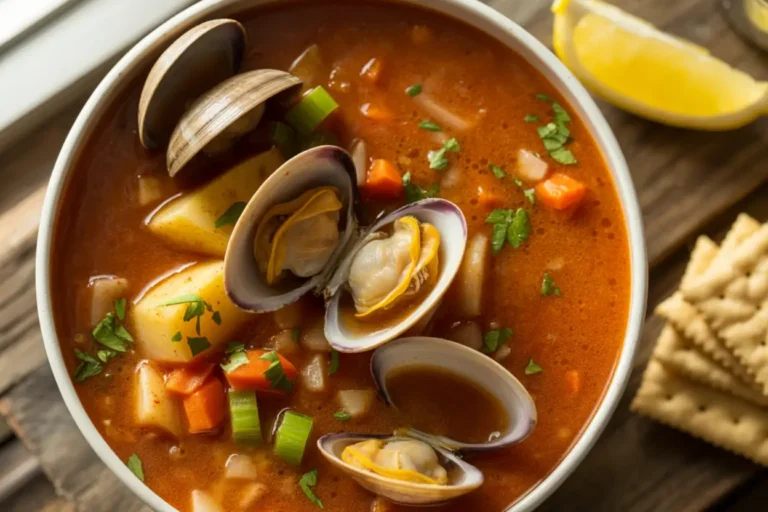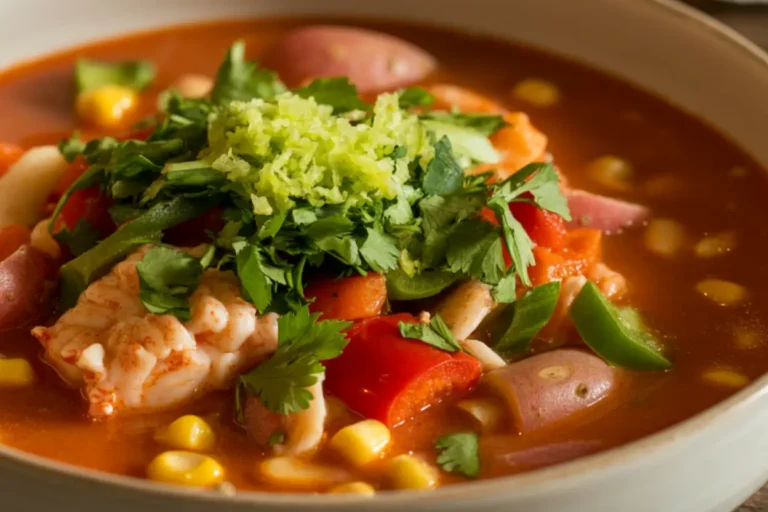Thai Fish Curry Recipe: How to Master It in 30 Minutes
Table of Contents
There’s something magical about a bowl of authentic Thai fish curry. The aromatic blend of lemongrass, ginger, and coconut milk creates a symphony of flavors that can transport you straight to the streets of Bangkok. While many home cooks might feel intimidated by Thai cuisine, I’m here to show you that creating a restaurant-quality Thai fish curry is not only possible but can be accomplished in just 30 minutes.
Thank you for reading this post, don't forget to subscribe!After years of perfecting this recipe, I’ve distilled it down to the essential techniques and ingredients that deliver maximum flavor with minimum effort. Whether you’re a novice in the kitchen or an experienced cook looking to expand your repertoire, this Thai fish curry recipe strikes the perfect balance between authenticity and accessibility. The result is a fragrant, creamy curry with perfectly tender fish that will impress family and friends alike. Let’s dive into how you can master this delicious dish in just half an hour!
How to Make Thai Fish Curry
Quick Overview
This Thai fish curry exemplifies quick yet impressive cooking, offering bold and complex flavors with minimal prep time. What sets this dish apart is the way the tender fish soaks up the fragrant curry sauce, resulting in melt-in-your-mouth bites layered with the signature spicy, sweet, salty, and tangy notes that define Thai cuisine.
One of the standout features of this curry is its silky, coconut milk-based sauce that’s simultaneously rich and light, coating each piece of fish and vegetable with layers of flavor. Despite its impressive depth of taste, this curry comes together remarkably quickly, relying on quality ingredients rather than complicated techniques.
From start to finish, you’ll spend just 30 minutes total on this recipe – 10 minutes of prep time and 20 minutes of cooking. This makes it perfect for busy weeknights when you want something extraordinary but don’t have hours to spend in the kitchen. Even better, most of the ingredients can be prepped ahead or kept on hand in your pantry, making this an accessible meal any day of the week.
The Ingredients I Use to Bring My Thai Fish Curry to Life
To create this vibrant Thai fish curry, you’ll need these essential ingredients:
For the curry base:
- 2 tablespoons vegetable oil or coconut oil
- 2-3 tablespoons Thai red curry paste (adjust according to your spice preference)
- 3 cloves garlic, minced
- 1 tablespoon fresh ginger, grated
- 1 stalk lemongrass, tough outer layers removed, finely minced (or 2 tablespoons lemongrass paste)
- 1 red bell pepper, sliced into thin strips
- 1 small eggplant, diced into 1-inch pieces (yields approximately 2 cups)
- 2 (13.5 oz) cans of full-fat coconut milk – for the richest flavor and creamiest texture.
- 2 tablespoons fish sauce
- 1 tablespoon palm sugar or brown sugar
- 2-3 kaffir lime leaves, torn (optional but highly recommended)
- 1 cup bamboo shoots, drained (optional)
For the fish:
- 1.5 pounds of firm white fish fillets (e.g., cod, halibut, or snapper), cut into 2-inch pieces
- 1 tablespoon lime juice
- ¼ teaspoon salt
For garnish:
- 1 cup Thai basil leaves (or regular basil if Thai basil is unavailable)
- ¼ cup fresh cilantro, roughly chopped
- 2 green onions, thinly sliced
- 1-2 red Thai chilies, thinly sliced (optional, for extra heat)
- Lime wedges for serving
Step-by-Step Instructions
Preparing the Fish
- Prepare the fish: Gently blot the fish fillets with paper towels to remove excess moisture. This step is important to remove excess moisture and ensure the fish doesn’t become too watery in the curry. Cut the fillets into 2-inch chunks – large enough to stay intact during cooking but small enough to be easily eaten with a spoon.
- Season the fish: In a medium bowl, lightly coat the fish chunks with 1 tablespoon of lime juice and ¼ teaspoon of salt, tossing gently to combine .The acid in the lime juice helps to firm up the fish slightly and adds brightness to the flavor. Set aside while you prepare the curry base. Don’t let it sit for more than 15 minutes, as the acid will begin to “cook” the fish if left too long.
Creating the Curry Base
- Heat the oil: In a large, deep skillet or Dutch oven, heat 2 tablespoons of oil over medium heat until shimmering but not smoking. Using a heavy-bottomed pan helps distribute heat evenly and prevents the curry paste from burning.
- Bloom the aromatics: Stir the curry paste into the hot oil and cook, stirring continuously, for 1–2 minutes until aromatic. This “blooming” step is crucial for developing depth of flavor, as it releases the essential oils in the spices. You’ll know it’s ready when you can smell the aromatic spices and the paste has slightly darkened.
- Add the garlic, ginger, and lemongrass: Stir in the minced garlic, grated ginger, and minced lemongrass. Continue to cook for another minute until everything is aromatic and well combined. Keep stirring to prevent burning, as these ingredients can quickly go from fragrant to bitter if overcooked.
- Incorporate the vegetables: Add the sliced bell pepper and eggplant cubes to the pan. Stir to coat them in the aromatic paste and cook for 2-3 minutes until they begin to soften slightly. The vegetables don’t need to cook through completely at this stage, as they’ll continue cooking in the curry.
Developing the Curry Sauce
- Add the coconut milk: Pour in the coconut milk, stirring continuously to incorporate it with the curry paste. If the coconut milk has separated in the can (which is normal), be sure to mix it well before adding it to the curry.
- Season the sauce: Add the fish sauce, sugar, and torn kaffir lime leaves (if using). The fish sauce provides saltiness and umami, the sugar balances the heat and acidity, and the kaffir lime leaves add their distinctive citrusy aroma. Stir well to combine all the flavors.
- Simmer the sauce: Bring the mixture to a gentle simmer—avoid boiling, as this can cause the coconut milk to separate. Lower the heat to medium-low and let it simmer uncovered for 5–7 minutes. This allows the sauce to thicken slightly and the flavors to blend. It should reduce by roughly one-quarter, becoming more concentrated.
- Add bamboo shoots: If using bamboo shoots, add them to the curry now and stir gently to incorporate. These add a pleasant crunch and authentic touch to the curry.
Adding the Fish and Finishing the Curry
- Add the fish: Carefully slide the fish chunks into the simmering curry sauce, distributing them evenly throughout the pan. Try not to stir too vigorously at this point to keep the fish pieces intact.
- Cook the fish gently: Cover the pan and reduce the heat to low. Allow the fish to cook in the simmering sauce for 5-7 minutes, or until it’s opaque and flakes easily with a fork. The exact cooking time will depend on the thickness of your fish pieces, but be careful not to overcook, as the fish will continue to cook slightly from residual heat after you remove it from the stove.
- Check seasoning: Carefully taste the curry sauce (avoiding the fish if it’s not fully cooked) and adjust the seasoning if needed. You may want to add more fish sauce for saltiness, sugar for sweetness, or a squeeze of lime juice for acidity, depending on your preference.
- Add the herbs: Once the fish is cooked through, remove the pan from the heat and gently stir in most of the Thai basil leaves, allowing the heat of the curry to wilt them slightly and release their aromatic oils. Reserve some basil for garnish.
- Rest briefly: Let the curry rest for 2-3 minutes before serving. This allows the flavors to settle and the fish to absorb more of the sauce.
- Serve: Ladle the curry into bowls, making sure each serving includes fish, vegetables, and plenty of the flavorful sauce. Garnish with the reserved Thai basil, fresh cilantro, sliced green onions, and sliced red chilies if desired. Serve with lime wedges on the side for squeezing over the curry just before eating.
What to Serve Thai Fish Curry With
Thai fish curry is delicious on its own, but serving it with the right accompaniments enhances the overall dining experience:
Traditional Thai Accompaniments:
- Jasmine rice: The most classic pairing, its subtle floral aroma complements the curry perfectly while soaking up the delicious sauce
- Coconut rice: For an extra indulgent meal, coconut rice adds another layer of rich flavor
- Rice noodles: Wide, flat rice noodles make an excellent alternative to rice
- Roti canai: This flaky flatbread is perfect for scooping up the curry sauce
Side Dishes:
- Som tam (Thai green papaya salad): The fresh, tangy flavors provide a perfect contrast to the rich curry
- Cucumber salad tossed with rice vinegar and a hint of sugar.
- Thai-style stir-fried morning glory or other greens
- A straightforward side of steamed vegetables, such as broccoli or bok choy
Beverage Pairings:
- Thai iced tea or Thai iced coffee
- A cold lager beer, such as Singha or Tiger
- For wine lovers, an off-dry Riesling or Gewürztraminer balances the spice nicely
- Coconut water for a non-alcoholic option that complements the coconut in the curry
For a Complete Thai Meal:
Begin with a small bowl of tom yum soup or a few fresh spring rolls, follow with the curry served over rice as the main dish, and end the meal with mango sticky rice or coconut ice cream for dessert.
Top Tips for Perfecting Thai Fish Curry
After making this curry countless times, I’ve developed these professional tips to help you achieve the most authentic and delicious results:
Selecting the Perfect Fish:
- Choose firm white fish that can hold its shape during cooking. Cod, halibut, snapper, and haddock are all excellent choices.
- Fresh is best, but high-quality frozen fish that’s been properly thawed works well too.
- Avoid delicate fish like sole or flounder, which can fall apart too easily in the curry.
- For a more luxurious version, try adding a few large shrimp or scallops along with the fish.
Curry Paste Considerations:
- Store-bought curry paste varies significantly in heat level between brands. Start with less if you’re sensitive to spice – you can always add more later.
- Mae Ploy and Maesri are excellent commercial brands that offer authentic flavor.
- If making your own paste, use a mortar and pestle for the most authentic texture and to properly release the oils from the ingredients.
- For a milder curry, reduce the amount of paste and add a bit more coconut milk.
Coconut Milk Secrets:
- Use full-fat coconut milk for the richest, most authentic curry. Light coconut milk lacks the critical fat content that carries flavor and creates the proper texture.
- If the coconut milk has separated in the can (thick cream on top, watery liquid below), mix it well before adding to the curry, or add the cream first and the liquid later for a smoother integration.
- Avoid boiling the coconut milk vigorously, as this can cause separation. A gentle simmer is all you need.
Balancing Flavors:
- Thai cuisine is all about balance between sweet, sour, salty, and spicy elements. Taste your curry toward the end of cooking and adjust as needed:
- Need more saltiness? Add fish sauce.
- Too spicy? Add a bit more coconut milk or sugar.
- Not enough tanginess? Add a squeeze of lime.
- Lacking depth? A touch more curry paste or fish sauce helps.
Common Mistakes to Avoid:
- Skipping the step of sautéing the curry paste in oil, which is essential for developing its full flavor.
- Boiling rather than simmering the curry, which can break the coconut milk
- Overcooking the fish, which makes it tough and dry
- Adding all ingredients at once rather than in stages
- Using low-quality fish sauce (look for brands from Thailand with minimal ingredients)
Ingredient Substitutions:
- No lemongrass? Use 1 teaspoon of lemongrass paste or 2 teaspoons of lemon zest mixed with a pinch of ginger.
- Kaffir lime leaves can be replaced with 1 teaspoon of lime zest, though the flavor will be different.
- Thai basil can be substituted with regular basil in a pinch, though the anise notes will be missing.
- You can substitute palm sugar with light brown sugar or even maple syrup.
- If you can’t find fish sauce, use soy sauce with a squeeze of lime juice, though this significantly changes the flavor profile.
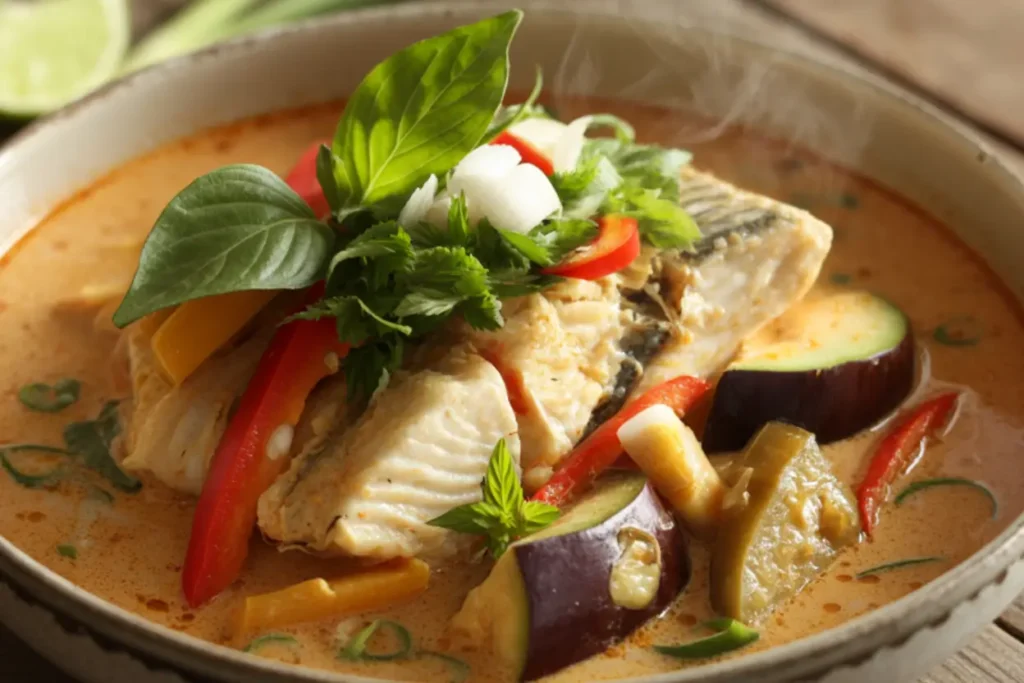
Storing and Reheating Tips
Thai fish curry is best enjoyed fresh, but with proper storage and reheating, leftovers can still be delicious:
Refrigeration:
- Cool the curry completely before refrigerating, but don’t leave it at room temperature for more than 2 hours.
- Store in an airtight container in the refrigerator for up to 2 days. The flavors tend to deepen overnight, although the fish’s texture may alter slightly.
- If possible, store the curry sauce separately from any remaining fish pieces. This prevents the fish from overcooking when reheated.
Freezing Options:
- Thai curry sauce freezes well without the fish and vegetables. If you know you’ll have leftovers, consider setting aside some sauce before adding the fish.
- Complete curry with fish is not ideal for freezing, as the texture of the fish will deteriorate, but it can be frozen for up to 1 month if necessary.
- Freeze in airtight containers with minimal air space to prevent freezer burn.
- Thaw frozen curry overnight in the refrigerator for best results.
Best Reheating Methods:
- Stovetop Reheating (Preferred Method):
- Gently reheat the curry in a saucepan over low heat, stirring from time to time.
- If the sauce has thickened too much during storage, add a splash of coconut milk or water to reach the desired consistency.
- Heat just until the curry is warmed through (about 165°F/74°C) – avoid boiling, which can toughen the fish and cause the sauce to separate.
- Add a few fresh herbs right before serving to brighten the flavors.
- Microwave Method (When Short on Time):
- Use a microwave-safe container and cover loosely.
- Heat at 50-70% power in short intervals (30-45 seconds), stirring between each interval.
- This gentler heating helps prevent the sauce from separating and the fish from overcooking.
- Be careful not to overheat – you want the curry just warm enough to enjoy.
Refreshing Leftover Curry:
- Add a squeeze of fresh lime juice when reheating to brighten the flavors.
- Garnish with fresh herbs like cilantro and Thai basil after reheating.
- A dash of fish sauce can help revive the flavors if they seem muted after storage.
- For curry that has thickened too much, a small amount of coconut milk restores the creamy texture.
Creative Ways to Repurpose Leftovers:
- Use leftover curry sauce (without the fish) as a poaching liquid for fresh fish or chicken.
- Mix leftover curry with steamed vegetables and rice for a quick one-bowl meal.
- Use as a flavor base for a seafood soup by adding more stock and fresh seafood.
- Blend the sauce with additional coconut milk for a unique soup base.
With these detailed instructions and professional tips, you’re now equipped to create an authentic Thai fish curry in just 30 minutes. This accessible yet impressive dish delivers restaurant-quality flavors with home kitchen simplicity, making it perfect for both everyday meals and special occasions. The vibrant colors, aromatic spices, and perfectly tender fish come together in a harmonious dish that will have everyone asking for seconds!
click here to follow me on pinterest
Thai Fish Curry Recipe: How to Master It in 30 Minutes
Cuisine: ThaiDifficulty: Easy4-6
servings20
minutes30
minutes400-500
kcalThis Thai Fish Curry is a vibrant and aromatic dish featuring tender white fish simmered in a rich coconut-based curry sauce. Infused with bold flavors from red curry paste, lemongrass, and fresh herbs, this comforting meal strikes a beautiful balance of spicy, sweet, salty, and sour hallmarks of classic Thai cuisine. It’s quick enough for a weeknight dinner but flavorful enough to impress.
Ingredients
2 tablespoons vegetable oil or coconut oil
2-3 tablespoons Thai red curry paste (adjust according to your spice preference)
3 cloves garlic, minced
1 tablespoon fresh ginger, grated
1 stalk lemongrass, tough outer layers removed, finely minced (or 2 tablespoons lemongrass paste)
1 red bell pepper, sliced into thin strips
1 small eggplant, diced into 1-inch pieces (yields approximately 2 cups)
2 (13.5 oz) cans of full-fat coconut milk – for the richest flavor and creamiest texture.
2 tablespoons fish sauce
1 tablespoon palm sugar or brown sugar
2-3 kaffir lime leaves, torn (optional but highly recommended)
1 cup bamboo shoots, drained (optional)
1.5 pounds of firm white fish fillets (e.g., cod, halibut, or snapper), cut into 2-inch pieces
1 tablespoon lime juice
¼ teaspoon salt
1 cup Thai basil leaves (or regular basil if Thai basil is unavailable)
¼ cup fresh cilantro, roughly chopped
2 green onions, thinly sliced
1-2 red Thai chilies, thinly sliced (optional, for extra heat)
Lime wedges for serving
Instructions
- Step 1: Prepare the Fish
Pat the fish fillets dry and cut them into 2-inch chunks.
In a bowl, toss the fish gently with lime juice and salt. Set aside (no more than 15 minutes) while you make the curry base. - Step 2: Build the Curry Base
Heat oil in a large skillet or Dutch oven over medium heat. Add curry paste and stir for 1–2 minutes until fragrant.
Stir in garlic, ginger, and lemongrass; cook for another minute.
Add bell pepper and eggplant; stir and cook for 2–3 minutes until just starting to soften. - Step 3: Create the Curry Sauce
Pour in the coconut milk and stir to combine with the curry paste.
Add fish sauce, sugar, and kaffir lime leaves (if using). Simmer gently (no boiling) for 5–7 minutes to thicken and develop flavor.
Stir in bamboo shoots, if using. - Step 4: Add the Fish and Finish
Gently add the fish chunks to the curry and simmer, covered, on low heat for 5–7 minutes until just cooked through.
Adjust seasoning to taste. Stir in most of the Thai basil and let rest for 2–3 minutes.
Serve with garnishes like cilantro, green onions, red chilies, and lime wedges.

